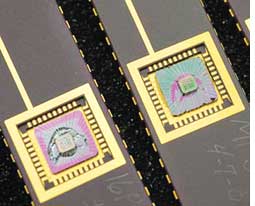Smells toxic
 A nano-sensor that works on the olfactory principle
A nano-sensor that works on the olfactory principle
THE human nose has inspired a team of researchers to create a similar device that smells the presence of toxic chemicals in the atmosphere.
The human sensor coordinates signals sent by thousands of sensory neurons to detect smells. The sensor, in this case, is a silicon chip which consists of nickel oxide nanoparticles acting as the neurons. When a chemical touches the surface of the oxide, it responds electrically; the response varies because each chemical has its own signature. The sensor detects the response and, in turn, helps identify the chemical.
Patricia Morris, professor of Chemistry at Ohio State University, with doctoral student Elvin Beach, had to first find a simple and easy way of making nanoparticles of nickel oxide. The nanoparticles would give the sensor a large surface area to quickly capture and identify a wide variety of chemical molecules. The team subjected nickel oxide to a pressure of 225
Related Content
- Order of the National Green Tribunal regarding repeated instances of fire in Kozhikode waste treatment plant, Kerala, 02/11/2023
- Preliminary report on oil well blowout and explosion at an OIL well in Baghjan, Tinsukia, Assam, 24/07/2020
- Order of the National Green Tribunal regarding unscientific carcass disposal site at Village Ladhowal, District Ludhiana, Punjab, 24/05/2019
- Contaminated liquid makes it way to Joburg site
- City smells like toxic spirit, pollution scan reveals
- Untreated, toxic effluents still discharged into Kalingarayan canal
